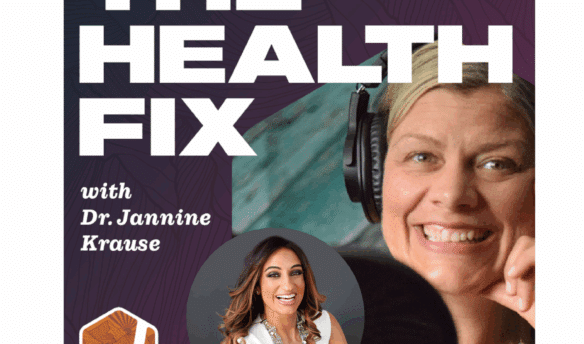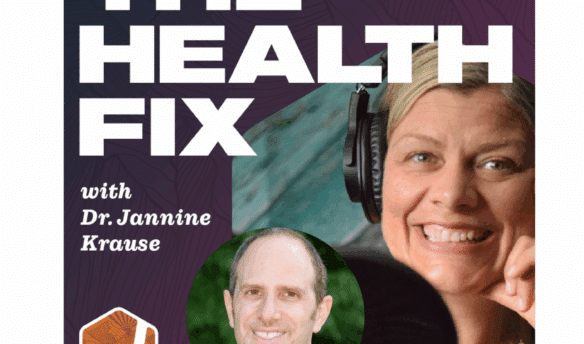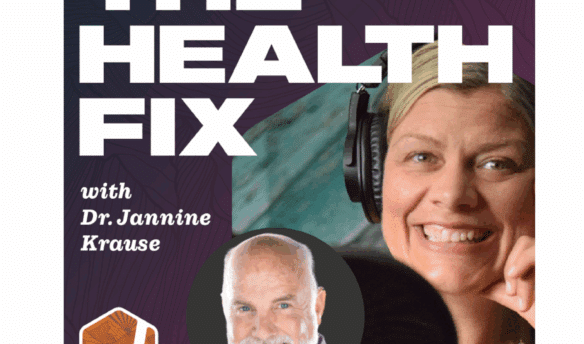Wanting to look deeper into why you repeat the same patterns of addiction, relationships or situations keep repeating themselves for you? Curious about embodiment and brain body connections? Wondering if EMDR (Eye Movement Desensitization and Re-processsing) might help with trauma or addictions? Alex Boianghu has been a psychotherapist for over 30 years and specializes in addiction and trauma treatment where he incorporates EMDR along with Eastern and Western psychology and philosophy principles to help clients reconnect with their bodies on a deeper spiritual level. In this episode of The Health Fix Podcast, Dr. Jannine Krause interviews Alex Boianghu on his philosopy of healing trauma, addiction and understanding yourself more intimately to ultimately heal what needs to be healed while awakening your own inner resources and capabilities to live with exuberance.
Dr. Krause’s Protocols
Instructions Included
Traveling soon? Looking to detox or reset your gut? Try one of Dr. Krause’s Fullscript plans.
What you’ll Learn In This Episode:
- What does it mean to live your life
- Why you develop layers of armor to feel “safe” in the world
- How EMDR helps you perceive trauma in a more objective light and release it vs keep it stored
- The art of sensing the world with your body
- Why the stories you tell yourself about events are what create individual trauma responses
Resources From The Show:
Our Partners
Podcast Transcript
JANNINE: [Intro] [Music playing] Welcome to the Health Fix Podcast where health junkies get their weekly fix of tips, tools and techniques to have limitless energy, sharp minds and fit physics or life.
JANNINE: Hey health junkies on this episode of the Health Fix Podcast, I’m interviewing Alex Boianghu. He’s a psychotherapist and he has been for over 30 years and he has worked with a lot of different situations from couples to families, individuals and working through all of life’s challenges. And here’s the interesting thing about Alex. His goal of therapy is to help you let go of outdated ways of living that can make you feel stuck or in survival mode. So that, you can live life in freedom, joy and success. Now we have a fabulous conversation and we really get deep with some things, especially trauma. We talk about EMDR. We talk about what it means to be alive and we talk about how trauma gets stored in the body and more of how it’s the stories we hold, not the score compared to what the book says. So this is an enlightening podcast, a deep one and we’ll get you thinking. So let’s introduce you to Alex Boianghu. Hey Health Junkies, I have Alex Boianghu. On with me today, he’s a psychotherapist. He’s been in the gig for over 30 years. I guess we just said 32 to be exact. It’s funny how time flies. And today we’re going to be talking about a subject I have not talked about before and I’m really excited to talk about it. Something called EMDR. And a lot of folks, Alex, have been telling me about like, hey, I’ve been trying this. It’s been working really well. And so I think this is an opportune time to really talk about how EMDR works and get the back story on you. So Alex, welcome to the HealthFix podcast.
ALEX: Yeah, thank you so much. Really excited. Looking forward to it.
JANNINE: So how did you, in the scheme of things, come to becoming a psychotherapist and working with EMDR? Give us your back story so everyone kind of has a little, you know, get to know you a little better.
ALEX: Sure. It’s a strange, you know, from a personal level at a young age, I was just really curious about who I am, what is life, why do we exist? You know, those existential kind of questions at a really early age. And I had some kind of insights and breakthroughs in my consciousness at a early age. I was just wondering if I was the one who answered that. I started to pursue that through some of the books that I started to read when I was a teenager. I met some spiritual teachers when I was also a teenager. And that kind of started the journey. And it’s been, you know, full-on throttle since that time. And my whole life has just been a deep dive into the exploration of being a spiritual human being.
JANNINE: Very cool, very cool. I really wish that I would have tapped into my conscious understanding of myself and had questions when I was younger. All I had in the back of my mind was, how can I become a professional snowboarder, which never happened? Here we are today. But I love it when I hear that folks were that connected and tapped in, you know, that early in life. That brings so much more of a rich experience to life, but also to being able to share that with others.
ALEX: Yeah, I mean, it’s nothing that I can say I own or it’s unique to me or something that I made or created. It’s just, you know, I don’t know how it works. I think this is the mystery. Some people get glimpses into, it’s like the Wizard of Oz. You know, some people get glimpses behind the curtains at different phases at different stages, different depths and so forth and some people don’t. I don’t know. I mean, it just happens to be, you know, I do believe that at a certain point if we start to do the work of the curtain gets pulled back more often and remains, you know, open. So I’m not sure if it matters how many experiences we had, but once we have one glimpse, that could be enough to last us a whole lifetime of being curious and exploring what is, what’s most meaningful in being alive?
JANNINE: Absolutely. Absolutely. So much in that, that statement right thing, you know, so much in that statement right there. And I think for a lot of us right now walking on this earth, we have disconnected from what it means to be alive. What that even means, what that even kind of brings forth in us and I think that might be some of the connection to where trauma lies within our bodies and how we kind of store it, how we, you know, work with it as a whole.
ALEX: You know, human beings throughout history, I would say, I mean, I think we sometimes try to paint any, you know, golden ages and, you know, disembodied men and embodiment. I wasn’t around for thousands of years. I don’t know, you know, what was and what, I don’t want to project some kind of golden era of sorts. The only thing I could say is from the anthropological studies of hunter gather tribes that we can study, they seem much more embodied because they live very embodied lives and they seem to be much more attuned to their bodies and they also seem much more connected to Mother Earth. So there seems to be a relationship between embodiment and nature, right? And then when we look at the movement from hunter gatherers into more agricultural and then science and technological movements, we’re getting away from embodiment and we’re getting more into mind arenas. And we can see that as mind arena, you know, accelerates, we have a loss of contact with Mother Earth. And so we see this relationship between our anthropological evolutionary development, right? And you know, when we look at the most modern times, we are the most separated that we have ever been and with technology now creating a multiverse online where people can now interact with each other in virtual worlds, I mean, which is just all mind. There is no embodiment whatsoever. And so then when we look at our modern illnesses of both mind and body, they arise out of a disembodied lives, right?
JANNINE: Yeah.
ALEX: And you know, trauma obviously, you know, impacts that ever so more, right? I mean, we’ve been disembodied to begin with and then trauma disembodies us even further. So that’s kind of like just to give a little bit of a framework of where we are at the moment.
JANNINE: Absolutely, absolutely. And, you know, obviously here we are, cross zoom, you know, recording this here even. And in a world that I would love is to meet everybody in person and sometimes I do get to do that outside of the podcast. But yes, it’s one of those things where we’ve lost that connection interpersonal, but also, yeah, I feel it when I haven’t been outside and had my, you know, hands and feet in the dirt. I feel it on a deep level and I see you shaking your head.
ALEX: If you look at our lives from the moment we wake up, right? Where are we making contact with nature, right? Returning to that source that nourishes us, right? It’s so beautiful, you know, to reconnect. But, you know, we have to reconnect internally and externally. And if we don’t know how to reconnect backwards internally, we’re not going to know and see that the, you know, external is available to us as an extension. So I think the journey has to begin with healing our wounds and our traumas and learning how to embody. And so that’s why I would say for the last, you know, probably 40 years, the embodiment movement has really picked up and has been growing, you know, Wilhelm Reich, you know, in the 1950s and 60s was really starting to look at the body and its role in psychotherapy and healing because, you know, the psychoanalytic movement obviously was completely disembodied.
JANNINE: Mmhmm.
ALEX: And so it was the somatic movement and Wilhelm Reich and some other folks that were doing, you know, body-centered work that started to look at how do we heal from the inside out? And you know, that coincided at the same time that yoga was coming to the West. And when we look at the embodiment movement happening in the 50s and 60s, yoga then starts to come in. Buddhism starts to come in and all of that meets together to start to reawaken the body as an important, you know, avenue for healing. That’s where that started.
JANNINE: I, you know, I think a lot of people have seen it. They’re coming on board with it and even folks have started to come into my office and even say like, hey doc, I’ve been working on some things. I think that, you know, I’ve got trauma stuck in my body. Can you help me release it? I’m an acupuncture. So sometimes folks will kind of, you know, tap into that side of my practice and say, hey, can we do acupuncture and you know, and really for me, I really didn’t start seeing a lot of this come into the medical field really until the last 10 years. I don’t think I, I mean, yes, I went to Bastyr. Yes, I’m a naturopath. We had a little bit more training than conventional docs, but even still on the same level, we were just like, it was two seconds of, there’s this EMDR thing. It’s cool. And then like, you know, onto the next. And so I didn’t get to explore as much of the concept of embodiment. I didn’t get to explore as much of the concept of, of some conscious mind, things of that nature in school. I thought that maybe we would talk about it, but we didn’t. And so it’s been a journey on my own of asking questions and exploring more. So just to give folks a little background in what’s happening in the medical field, you know, we’re coming along. But even within the natural medicine space, it’s not something that you get as part of your standard training. You’ve got to look elsewhere. So I ask, of course, you know, most folks who I see on the podcast, like, okay, when did you first start learning about EMDR? When did you first start learning about trauma, things of that nature in terms of your field, but also in terms of your own exploration?
ALEX: I knew early on that I wanted to do somatic therapy because I was an athlete. I was a yoga person and I became a yoga teacher at a very early age. And I knew the power of that. And so I actually trained with probably the first system, maybe in the United States, possibly. I don’t want to be quoted exactly, but I think it was the first system called Phoenix Rising Yoga Therapy. And this was, oh God, 80s, early 90s, like this was right there. I don’t remember any other systems that were being offered as a full comprehensive system. And the way that this work was that we were using yoga breath work to help people release traumas, understand traumas and become embodied. And it was beautiful, beautiful, beautiful training. And I got to work with people early on in my career, immediately doing that work. And I could not believe how powerful it was. So that was my first introduction. And once that started going, I was just like fully in and I started to study bioenergetics, Hakomi. I mean, it goes on, somatic processing. I mean, literally every system that was on I threw myself into. So I’m very familiar with the somatic field.
JANNINE: So I think a lot of people might be going, okay, somatic field. How does that relate, you know, specifically because most folks experience of psychotherapy as they go in, they sit down, they talk, they talk about all the traumas, they talk about all the things. And then they leave and sometimes there may be depending on the folks that they’re working with, there may be some homework, there may be something to focus on. But a lot of times I’ve found that it’s just rehashing over and over again, the traumas. So tell us a little bit more about how you’re incorporating in embodiment, incorporating in EMDR, things of that nature. How does it work? And then of course, we want to talk about what is EMDR and all that. I’ve been saying it over and over again.
JANNINE: So I’d like to back up and to do a little bit of an understanding of what it means to be human.
JANNINE: Yes.
ALEX: So when we’re being developed in utero, the nervous system is the interface between the muscular system, the skeletal system, and then on the inside, on the subtle energy and the body that we cannot see, the energy body. So if we think about the nervous system, it’s the interface between the energy system and the manifest system of bones, density, muscles, cellular and so forth, right? So the nervous system is such a, it’s just absolutely mind blowing. It’s this living, alive, intelligent, I don’t know, mechanism. And it is what receives information, deals with information and then has output, right? And it connects to the mind, to the emotions and the body. So the nervous system is picking up information all the time, all the time. That’s what starts to happen because as a human being, our first primary goal is to survive. That is the first primary goal. In order to thrive, we have to get through just an incredible amount of survival. I mean, you think about it like nine months being formed with the most miraculous cellular endocrine—I mean, like talk about miracle of coming into being, right? All of that has the interface of this nervous system and it’s picking things up and it’s forming, it’s forming the body as information, it’s forming the mind, even though the mind is not sort of operating as an I.M. at this point. So in Euro and Stanislav Graf has done a lot of work around this, that the mother’s energetic system is influencing the early formation of this nervous system. It’s getting input. So the mother’s nervous system, the mother’s emotions, her, you know, blood work and cytokines and inflammatory markers, just everything is going into the baby and giving information. What is this early environment like? If the nervous system starts to pick up that it is starting to be unsafe, which it will, it’s going to start to create rigidities already, formations around patterns of relating and it starts that early. It’s incredible, right? So the child is then born into the next environment. Next environment is the family environment, the socio-political cultural environment, right? Each one of it with its own unique vibrations growing up in China is very different than growing up in South America. I mean, you know, like each country actually has its vibrations and it gets into the child’s formation and it creates crusts and points of disconnection. So the way we always assumed historically that trauma was these big events, the big traumas, as we always think, you know, sexual traumas, physical abuse, you know, violence in the home addiction, you know, we can name all that, what we call the big teas, right? But just being human, there’s no escaping from the biological systems that are around us, that are in their own confusion, in their own pain and their own hurt and their own capacities, lack of capacities to deal with with life, right? All of that is coming in and forming the nervous system. Just imagine that. And that’s already, that’s trauma in the sense the small teas are basically saying it’s safe or unsafe to be me. This is very important. How many of us can say we grew up in an environment where we felt like I could be authentically myself?
JANNINE: I don’t know anyone.
ALEX: Very, it’s very small, very, very tiny, very, very tiny amount of adults will say I, you know, really felt like so respected and so loved to be authentically myself. There are people, I mean, they’re very fortunate, but it’s a very small number. And so then the rest of us grew up in varying degrees from little to the most violent where there is no room to be myself. So trauma is the encrusting around my authentic self. And basically what happens in that crusting, it’s information that says I cannot be myself and I need to wear this crusting and create a distance from myself and others. And I have to wear this jacket to get through life and get along. But fundamentally the way I experience myself on the knee that is I feel alone and disconnected from myself and others.
JANNINE: Mmhmm.
ALEX: And that’s what I see almost everybody coming to see me for. A deep disconnection from themselves and from others, not because it’s their fault. It’s what was, what has occurred throughout life and the, what’s, you know, the secondary injuries that once the momentum of this happens, we then unconsciously continue to reinforce it.
JANNINE: Yeah.
ALEX: Again, not because we want to, it’s just habit. It’s just how we then function. It’s a self perpetuating system, right? That carries itself along and then we’re shocked that, you know, the third relationship that we’ve had in our 20s is the same thing as the first one and we’re like, what happened? Right. You know what I mean?
JANNINE: Why do I have such bad luck? You know, we’ll ask that.
ALEX: No such thing. And then finally, there comes a point where we go, hold on a second. I have to explore what role I play in my life in its well-being or its suffering. And then that is the beginning of the healing journey.
JANNINE: Taking, taking accountability, accepting that you have a play in that is huge. It’s huge. I find that, and I’m curious as to how you find some folks in terms of coming to this conclusion. Sometimes it’s, I find that not a lot of folks, let’s say that’s more and more becoming ready to dive in. But there is still some resistance to this, of course.
ALEX: Look, I think that by the time people come to see me, they’re sick and tired. So I’m getting people, you know, at a point of where they want transformation, you know what I mean? But we could also, we also could look around in our lives and there’s plenty of people that we know family members and friends who are continuing in the momentum of their confusion and suffering with no actual desire to investigate themselves and its all life and others that are causing my suffering. And that’s just a recipe for disaster.
JANNINE: Mmhmm, Mmhmm. No, absolutely, absolutely. And you know, obviously part of this podcast for me is always helping folks to open their eyes to new things, new possibilities, things of that nature. Of course, by the time, you know, someone’s coming to sick and tired of things that they have come down a really long realization of, of, wow, maybe there’s a pattern that keeps you repeating and maybe I have a play in this, this sort of thing. And definitely with, with addictions, I see that that’s something else that you, you specialize in. Can we talk a little bit about how that plays out in addictions?
ALEX: Yeah, I mean, if you look at what I described, addiction basically is the attempt to deal with the encrusting ineffectively. That’s a simple of an explanation without getting fancy at all. That’s what’s happening, right? And so because it’s too painful to go into the crust and to deal with all the things that are there, it’s ineffective. And it doesn’t, it doesn’t actually go to heal it, it just goes to numb it. So addictions are numbing of the encrusting. Makes sense?
JANNINE: Absolutely, absolutely.
ALEX: Well, I like that. I mean, simplifying it makes sense to everybody.
JANNINE: It does to me. I mean, it definitely does to me and probably lasts as more when it comes to our bodies because there’s so much information out there right now that we have access to that it can almost hold us in a place of paralysis versus action. Or, or, and I don’t even mean the word action. Like, I think confusion maybe might be more better word than less of action, not knowing which direction to go.
ALEX: Once there’s enough, hopefully, you know, we all need a different amount of suffering to get us to that space to start to include ourselves in the process. But like I said, I’ve known people who have died in their 70s and 80s and have never examined their lives. You know, what’s that saying? An unexamined life is not worth living, right? Or an examined life is the only life worth living. Right? So the potential for healing is so beautiful. You know, when people start to taste, you know, relief and healing where that crust starts to, you know, peel away and fall away, it’s like, oh, it’s like, wow, I think I’m addicted to watching people’s relief. That’s my addiction, you know, to observe that process. It’s just incredible. You know, because once they start to taste that, they’re like, I never imagined that this is possible. And of course, it’s hard to imagine it when, you know, we’re within the encrusted lens. It’s very difficult to imagine any other way of viewing something. So here comes EMDR, right? So let’s bring in EMDR at this point to take a look at how EMDR helps with shifting perspectives. So you know, people can look at EMDR. There’s a lot about it, but I’m going to give a short summary of it. So it makes sense. The acronym stands for Eye Movement De-Sensitization and Reprocessing. But let’s leave that alone. So as we were engaging in the wars in the 1900s and vets were coming home and they’re like, was witnessing of patterns of suffering, which eventually was titled PTSD. Before that official title, you know, we didn’t understand what PTSD and veteran syndromes were. People were coming back and we didn’t know what to do with that, right? So we saw psychosis, drug addiction, alcohol addiction, all sorts of addiction, suicide rates, right? And these were all the impacts of being in war and traumatized. And eventually as the field progressed and there was a naming of this syndrome called PTSD, the treatments were still very, very poorly effective, quite not so effective. The idea was the early cognitive behavioral was you do exposure therapy. And what eventually we found out was that that’s not the correct way to deal with that and all other forms of PTSD and traumas, right? So friends seeking Shapiro about 25 years ago was the woman who developed this through an insight that she had. And the way that EMDR works is that it consists of something called bilateral either tapping or moving of the eyes. And so what happens in this tapping or eyes or any bilateral process is the brain goes into a slightly hypnotic state. And in that hypnotic state, the emotions that arise in a particular trauma, a slightly calmer. And when the emotions are slightly calmer, the person can actually perceive the event in a more objective light. And by witnessing the event in a more objective light, they can actually see who they were actually in that. So you take a child who, let’s say, has some trauma. Most of the time they will believe that it was their fault. And so I just had a session before this and this gentleman, his mother was quite ill and caused a lot of trauma and drinking. And he would believe that it was his fault that she was drinking, right? And during EMDR, we revisit that while tapping and all of a sudden he realizes, oh my goodness, this had nothing to do with me. It wasn’t my fault. I’m a good person. And then what happens is we learn to invite, to feed the outcomes of somatic parts, then we support him through a meditative way of experiencing his own wholeness and freedom and through love to come back to himself and realize it wasn’t his fault. So that’s the short version of the way that EMDR works.
JANNINE: Okay. So a lot of the people that’s staring at me like, okay, so we’re going back to childhood, we’re going back in time.
ALEX: Anywhere. Anywhere. It doesn’t matter. It could be yesterday, right?
JANNINE: Okay.
ALEX: We’re bringing up memories that are still lodged in the psyche and the body that have not been resolved and been given. See, the body and the mind wants to put everything in its right space. When it’s misplaced, it just keeps arising in the unconscious as well through sicknesses and illnesses and misperceptions and aggressions and anger and reactions. All disturbances and so forth. All of those are symptoms of trauma not being correctly worked out. So we use these memories and we activate them in the body to allow them to be released but with the right objective distance and perspective.
JANNINE: Okay. Okay.
ALEX: And then the brain can then put it in its right space without all of the emotional activation because what happens is when you that have a memory without the emotional activation, what do you have? It’s just the memory, just visual. Do you know what I mean?
JANNINE: Mmhmm.
ALEX: When I was 21, I saw someone get violently killed in front of me and I never had EMDR but I think just my temperament is that when I have that memory now and since 21, when I have the memory, I have the memory but I don’t have any emotional reaction to the memory except compassion for the young man who died. Do you know what I mean? But it doesn’t destroy my day or anything. It actually inspires me to live more fully. Right? So I didn’t feel it was my fault. I’m that or some kind of I am that was involved that was distorted. Right? So that’s a trauma that was correctly digested by my system. Does that make sense?
JANNINE: It does. It does. One of the things that I’ve kind of dove into and really something you imagine was the emotional attachment to what you saw and then of course we give things meaning right and then we have emotion then we have the next wherever we store it. So if we’re looking at that and I’m guessing beyond that other traumas have happened because we all have the big t’s and the little t’s. Has it been your habit just out of understanding how the body works and how things work? To not attach emotion because I mean you mentioned compassion but to not attach emotion give things meaning what’s— what would I guess what I’m asking is what’s— what could be the learning lesson here from what you experienced and what others you know what what happens with others. I guess that can’t disconnect.
ALEX: Let’s put it this way. It’s not that you can actively choose a particular emotional response when a trauma is happening. That’s not what we’re talking about. It’s everybody’s got a different temperament and already a whole entire system that so take take this system from childhood that has been wired a certain way bring it into adulthood and let’s say take ten of those different systems all the way from stable internally to quite unstable and the same event happens to them. Each person will integrate that event based on their previous historical trauma patterns. Right? So their emotional response is dictated by previous emotional responses.
JANNINE: Okay.
ALEX: It’s important to understand. What I think we all should be curious about is how we respond to everyday life’s events and to see how much weight what’s our perspective, how much emotionality is it really like sometimes step back and be like interesting like wow that’s interesting very intense response. And then do some processing with that. Right?
JANNINE: Okay. I’m following you now. I’m following you now. I think other folks may be too in terms of like, okay, obviously we all respond different. We all have the information that we’ve learned over the years and how we respond to certain things. Now something happens. The goal is to understand yourself enough to be able to process differently.
ALEX: It’s hard to do it during it, but afterwards. So an event happens and you’ve been curious about yourself and you go, wow that’s so interesting the way I lensed it. The way I said my responsibility, that person responsibility, the way I storied—, storied it. Right? Very, very important. You know, like let’s say you’re working, your coworker says, yeah, I’m not really happy the way you did that today. That, that, that, you know, those photo copies, the way you did that, I’m not really happy with that. And one person comes home and goes, whatever tomorrow’s with that, another person, oh my god, I cannot believe I think they hate me and oh no, no, my world’s going to fall apart. Right? So you know how that goes. And then it’s got a different response to that event.
JANNINE: Yes, I laugh. I laugh only because I’m the one that the world’s going to fall apart if I did something wrong. And I, and you know, and I’m, for those of you listening, I’m only laughing because it’s me, you know, I’m just no disrespect to anyone. I only know what I experience. And part of it is entertaining in that I’ve done enough self-expression to go into, okay, why do I have that experience? And I know it comes from my dad and I know it comes from certain things I learned and with him still being alive, still here, but now I can put that barrier into this. And so I think what I’m going for here is, how does it work for folks now in terms of those responses we can catch ourselves? How do you teach folks to catch their responses? How do you teach folks to work backwards from or how, how are you explaining it?
ALEX: A lot of mindfulness. A lot of mindfulness practice, a lot of meditation practice because the signs that were activated in a particular transmode begins in the body. The body gives us the energetic body starts to vibrate a certain way that starts to give a clue that this is the beginning of the trauma response, right? Once we are really aware, we can actually witnessing it arising. And then if we’re really attuned, we can watch it arise but not react then to it. Simply it’s just like witnessing, arising, we’ll be smiling, we go, “Hi old friend, hello, darkness, my old friend.” [laughing] And then it comes through, you let it go and then you’re like, “Yep, I don’t need to deal with it that way.” And I have new ways to deal with it that are much more effective, much more in line with who I am and respective of the other person, right? So lots of tuning in to the somatic.
JANNINE: Mmhmm, Mmhmm.
ALEX: If we’re trying to do this from the headspace of the mind, it’s very difficult because the mind is like the last place where the symptoms are occurring of the trauma response, the body is the first.
JANNINE: Mmhmm. And so for a lot of people paying attention to when something comes up, looking to see where it lands in the body is where I’m gathering.
ALEX: That’s right. Where does it show up in the body? What does that signify? What is the story in that response? What is the particular “I am? What’s the goal? What are the fears?” The book of the body keeps the score by a basic language, right? So the body keeps the story, not the score, but the story. That’s what it should have been in the name of the book, it keeps the story, right? So that response has an entire book there. If you know how to read the book, you know how to heal.
JANNINE: Yeah, yeah. Absolutely. Absolutely. I think this is something that I’ve come to after a long time of obviously being a doc going on, you know, 19 years this year, but really just kind of looking at, “Huh. Okay. You know, a lot of what happens to us is a result in terms of symptoms, things of that nature are a result of past traumas and behavior, subsequent behaviors and habits that lead to those. It’s kind of what I’ve summed it up as. It’s not that it just randomly happened to you that you have abdominal pain or gut issues.
ALEX: Look at the word, look at the word disease. It comes from the word dis-ease. Well, when the body is not at ease, it becomes sick. So if we want to take a look at why we’re sick, we have to look at why we are dis-eased.
JANNINE: Mmhmm. Absolutely. Absolutely. So moving through folks understanding this, you know, concept of disease, understanding that they’re storing different emotions, thoughts, traumas, etc. in their body, I have heard, and I want you to kind of help us with understanding this because I’ve heard a lot of people say EMDR helps me get these things out of my body. And we’ve already kind of talked about how that’s not necessarily the concept, but I think what folks are wanting to understand is how does eye movement help to bridge the gap there with the neurological system and help with correcting?
ALEX: No, don’t worry about the eye movement or the tapping. Simply understand that all of the all bilateral movements induce a hypnogenic state. That’s the most important. The science on that is ever evolving. But if you look at traditional societies, Native American people would dance around the fire and you would see them stomping. If you look at the Sufis and the way they dancing and they do the call to prayer, they’re doing it bilaterally. So there’s, I think there’s something in human beings that has something to do with the crossover in their brain in bilateral movements inducing hypnotic states. If you look at the Sufis that during this dance and they’re making contact with the divine, what that means is that they’re blissing out completely and letting go, in this case, what we would call from the default mode network. So the hypnogenic state is basically turning off the default mode network. The default mode network is basically all the stored belief systems of self in the mind that are inaccurate. And so these hypnogenic states, basically, they go lights off on that and then you experience absolute bliss. And that’s why people like to use all sorts of psychedelics because psychedelics and ketamine and so forth, those actually work exactly the same way is by turning off the default mode network. And so when we do that, people experience euphoria and bliss and so forth and so forth. But it does not mean that they are actually transforming the underlying psychic structures and the bodily health experiences because that moment has occurred. That moment is just to give you the clue of what is possible.
JANNINE: I’m glad you explained that. Go ahead.
ALEXL It comes to hard work.
JANNINE: Yeah, yeah. I think it’s come to, let’s say this way, I think it’s come to my understanding at least based on how it’s discussed in my office. A lot of folks think that the ketamine is the psilocybin. All of these different ayahuasca treatments are going to purge whatever it is or they’re going to see the solution and then all is good after doing those and unfortunately, like you said, not the —
ALEX: This is not about purging this notion that it’s really interesting that we have this idea like purging and then I’m good and I understand it because we want to throw up all that’s being held within us, right? So during those hypnogenic states, right? Yes, there’s a sense that we’ve purged, but what it’s done is that we just turned the system off temporarily, right? But in order to turn that system off like longer times and eventually completely transform it, that’s a lot of work. Steady, day in and out, embodiment and meditation and coming back home again and again, again and again. And to be honest with you, we’re very lazy and we want all of this to be resolved and to return back to our true nature and our inner homes and just like this. So if we’re going to be lazy, well, good luck.
JANNINE: Yeah, yeah. I agree with you. We’ve unfortunately kind of moved into a society since probably the antibiotics were developed of, here’s the pill, here’s your solution.
ALEX: Quick, quick fix. I’m going to go on ayahuasca trip. I’m going to come back. I’ve seen people come back from ayahuasca trips and have the most amazing trips and they’re the same, same as they were before.
JANNINE: Yes. Yes. Yes.
ALEX: Not that people haven’t had insights or some transformations. I mean, obviously, but then, you know, it’s not like you’re going to keep going to them for the full transformation. There’s a lot of work that has to be done and I really, you know, without having a guide to do this transformation, you know, I don’t care. You know, a religious person, a psychotherapist, a spiritual teacher, a coach, like somebody who knows what they’re doing to guide you. You can’t do this by yourself. Just like I, just like, you know, I can’t do certain things for myself. I don’t know how to fix my own car.
JANNINE: What about, so I always like to ask folks, like, who’s your mentor, who’s your guru, who’s your guide out of curiosity? Or do you have multiple?
ALEX: Throughout my lifetime, I’ve had several. At the moment, I have my most beloved teacher, Lopon Barbara Dubois, who is an amazing Buddhist teacher out from Arizona. And she is, you know, she’s everything to me.
JANNINE: I’ve heard her name before. I’ve heard her name before. Not sure why, but perhaps in some circles, but very interesting. You know, I always like to hear who’s, who’s, who’s, you know, guide or mentor, because I think it’s important for folks to understand that all of us have, well, at least most of us, I should say, that are in the space of working with others and wellness and should have a guide.
ALEX: I, I, I, I, I am with her on a regular basis, either in person or on, on Zoom, and we’re, we’re connecting and deepening and deepening that contact with, with the quality of being old. JANNINE: Mm hmm. Mm hmm. So, for folks who are listening at this point, Alex, and they’re kind of going, okay, I, I’m ready to start this process of really taking the next step to figure out who I truly am, you know, work through things I want to do the hard work. What would you advise them to do is their first step, and, and of course, we’ll get into how they can work with you as well.
ALEX: Look, I’m biased in a sense that, um, I, for me, if they want the, the, the, the quickest, way is, is, somebody who does embodied somatic psychotherapy and knows EMDR. If I’m going to combine, those would be the two, like, secret weapons. Talk therapy for me is sorry I’m going to do this for the people, but it’s on waste of time. I would find somebody who really knows how to do that well and then, you know, someone you connect with, with your trust and begin the process.
JANNINE: Makes sense. Makes sense. And then, if they’re looking to work with you, how does that work?
ALEX: Simple. You know, my website, journeytowholeness.health, easiest way, they can read all about me, all my, all my stuff on there, and they can send me a text on email and I’ll get back to them.
JANNINE: Sounds good. Sounds good. Well, we’ve had a very interesting conversation, went down in a lot of different avenues. I appreciate you taking the time and being real with us. Because I think for a lot of folks, this is going to be an eye opener for them to, to hear how it really is in, in working through our, our traumas and, getting to know ourselves.
ALEX: Thank you very much. And, you know, what I would say is this healing is possible for all of us. It’s very important. And not, none of us are doomed to the conditioning that was. We all have the capacity to be fundamentally free.
JANNINE: Absolutely. Absolutely.
ALEX: Thank you.
JANNINE: Well, well said. Well, thank you so much for coming on. We’ll definitely be digesting this one and, and thinking about and having a good conversation going forward. So, thanks again, Alex for coming on.
ALEX: Thanks a lot.
JANNINE: [Outro] Hey fellow health junkie, thanks for listening to the HealthFix podcast. If you enjoyed tuning in, please help support me to get the word out about the podcast. Subscribe, rate and review, and just get that word out. Thanks again for listening. (upbeat music)














